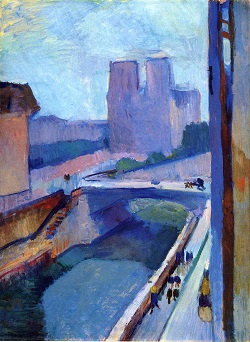Henri Matisse
Henri-Émile-Benoît Matisse ( 31 December 1869 – 3 November 1954) was a French artist, known for his use of colour and his fluid and original draughtsmanship. He was a draughtsman, printmaker, and sculptor, but is known primarily as a painter. Matisse is commonly regarded, along with Pablo Picasso and Marcel Duchamp, as one of the three artists who helped to define the revolutionary developments in the plastic arts in the opening decades of the twentieth century, responsible for significant developments in painting and sculpture. Although he was initially labelled a Fauve (wild beast), by the 1920s he was increasingly hailed as an upholder of the classical tradition in French painting. His mastery of the expressive language of colour and drawing, displayed in a body of work spanning over a half-century, won him recognition as a leading figure in modern art.

Henri Matisse 1911
The first painting of Matisse acquired by a public collection was Still Life with Geraniums (1910), exhibited in the Pinakothek der Moderne. His The Plum Blossoms (1948) was purchased on 8 September 2005 for the Museum of Modern Art by Henry Kravis and the new president of the museum, Marie-Josée Drouin. Estimated price was US$25 million. Previously, it had not been seen by the public since 1970. In 2002, a Matisse sculpture, Reclining Nude I (Dawn), sold for US$9.2 million, a record for a sculpture by the artist. Matisse's daughter Marguerite often aided Matisse scholars with insights about his working methods and his works. She died in 1982 while compiling a catalogue of her father's work.
All of images and text at art-Matisse.com is only being used for informational and educational purposes; the images is readily available on the internet.

 260x391cm.jpg)
